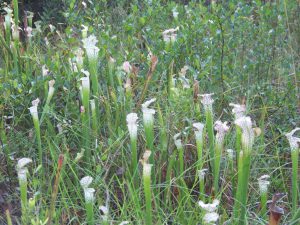Growing up I have always been fascinated by aquatic environments. Whenever I was close to a creek or river, I lifted up rocks looking for salamanders or crayfish. I would drive my dad crazy as I take the fishing net to the lake shore and scooped out the aquatic weeds to see what I caught while he was fishing. As I grew up, my fascination shifted, especially when I moved to south Florida. Florida is home to about 20% of the wetlands in the United States and my favorite type of wetland is the bog.
What is a bog?
A bog is defined by the Merriam-Webster Dictionary as “a poorly drained usually acid area rich in accumulated plant material, frequently surrounding a body of open water, and having a characteristic flora (https://www.merriam-webster.com/dictionary/bog).” In Florida, the typical type is called the Shrub Bog. These contain dense stands of short shrubs vines and trees. It is also fire-dependent to keep it from developing into a forest. Bogs are areas where organic matter has accumulated, often including sphagnum moss. This accumulation along with no water outflow creates a very acidic low oxygen environment to which plants have had to develop adaptations to.
Life in a bog

This includes numerous animals such as turtles, frogs, and even black bears. However, it’s the plants that make bogs so interesting. You can find normal wetland plants like Cypress, wax myrtles, elderberry, and gallberry. More fascinating plants adapted to the low nutrient availability by developing ways to trap and eat insects. Yes, bog gardens are the natural habitat for carnivorous plants.
As you may expect life in a bog plants and animals that can stand a wet environment.
This is the first of a series of blogs that will introduce you to how to build a bog garden and some of the plants, Carnivorous and not, to incorporate into it. This interesting type of garden can be a great teaching tool for children.
 0
0
